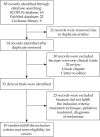Non-melanoma skin cancer treated with high-dose-rate brachytherapy: a review of literature
- PMID: 28115960
- PMCID: PMC5241375
- DOI: 10.5114/jcb.2016.64112
Non-melanoma skin cancer treated with high-dose-rate brachytherapy: a review of literature
Abstract
Purpose: The incidence of non-melanoma skin cancer (NMSC) has been increasing over the past 30 years. There are different treatment options and surgical excision is the most frequent treatment due to its low rates of recurrence. Radiotherapy is an effective alternative of surgery, and brachytherapy (BT) might be a better therapeutic option due to high radiation dose concentration to the tumor with rapid dose fall-off resulting in normal tissues sparing. The aim of this review was to evaluate the local control, toxicity, and cosmetic outcomes in NMSC treated with high-dose-rate BT (HDR-BT).
Material and methods: In May 2016, a systematic search of bibliographic database of PubMed, Web of Science, Scopus, and Cochrane Library with a combination of key words of "skin cancer", "high dose rate brachytherapy", "squamous cell carcinoma", "basal cell carcinoma", and "non melanoma skin cancer" was performed. In this systematic review, we included randomized trials, non-randomized trials, prospective and retrospective studies in patients affected by NMSC treated with HDR-BT.
Results: Our searches generated a total of 85 results, and through a process of screening, 10 publications were selected for the review. Brachytherapy was well tolerated with acceptable toxicity and high local control rates (median: 97%). Cosmetic outcome was reported in seven study and consisted in an excellent and good cosmetic results in 94.8% of cases.
Conclusions: Based on the review data, we can conclude that the treatment of NMSC with HDR-BT is effective with excellent and good cosmetics results, even in elderly patients. The hypofractionated course appears effective with very good local disease control. More data with large-scale randomized controlled trials are needed to assess the efficacy and safety of brachytherapy.
Keywords: HDR brachytherapy; radiotherapy; skin brachytherapy; skin cancer.
Figures
Similar articles
-
Brachytherapy in non melanoma skin cancer of eyelid: a systematic review.J Contemp Brachytherapy. 2015 Dec;7(6):497-502. doi: 10.5114/jcb.2015.56465. Epub 2015 Dec 16. J Contemp Brachytherapy. 2015. PMID: 26816508 Free PMC article. Review.
-
Non-melanoma skin cancer treated with high-dose-rate brachytherapy and Valencia applicator in elderly patients: a retrospective case series.J Contemp Brachytherapy. 2015 Dec;7(6):437-44. doi: 10.5114/jcb.2015.55746. Epub 2015 Nov 23. J Contemp Brachytherapy. 2015. PMID: 26816500 Free PMC article.
-
Does an Algorithmic Approach to Using Brachytherapy and External Beam Radiation Result in Good Function, Local Control Rates, and Low Morbidity in Patients With Extremity Soft Tissue Sarcoma?Clin Orthop Relat Res. 2018 Mar;476(3):634-644. doi: 10.1007/s11999.0000000000000079. Clin Orthop Relat Res. 2018. PMID: 29443850 Free PMC article.
-
Review: the reemergence of brachytherapy as treatment for non-melanoma skin cancer.J Dermatolog Treat. 2018 Mar;29(2):170-175. doi: 10.1080/09546634.2017.1341617. Epub 2017 Jun 30. J Dermatolog Treat. 2018. PMID: 28604229 Review.
-
HDR brachytherapy for superficial non-melanoma skin cancers.J Med Imaging Radiat Oncol. 2013 Apr;57(2):212-7. doi: 10.1111/j.1754-9485.2012.02466.x. Epub 2012 Oct 29. J Med Imaging Radiat Oncol. 2013. PMID: 23551783 Clinical Trial.
Cited by
-
The feasibility of using ultrasound during follow-up for superficial non-melanoma skin cancers after electronic brachytherapy.J Contemp Brachytherapy. 2017 Dec;9(6):535-539. doi: 10.5114/jcb.2017.72358. Epub 2017 Dec 30. J Contemp Brachytherapy. 2017. PMID: 29441097 Free PMC article.
-
S2k guideline basal cell carcinoma of the skin (update 2023).J Dtsch Dermatol Ges. 2024 Dec;22(12):1697-1714. doi: 10.1111/ddg.15566. Epub 2024 Nov 25. J Dtsch Dermatol Ges. 2024. PMID: 39584658 Free PMC article.
-
Keratinocyte Carcinomas: Current Concepts and Future Research Priorities.Clin Cancer Res. 2019 Apr 15;25(8):2379-2391. doi: 10.1158/1078-0432.CCR-18-1122. Epub 2018 Dec 6. Clin Cancer Res. 2019. PMID: 30523023 Free PMC article. Review.
-
Individualized 3D scanning and printing for non-melanoma skin cancer brachytherapy: a financial study for its integration into clinical workflow.J Contemp Brachytherapy. 2017 Jun;9(3):270-276. doi: 10.5114/jcb.2017.68134. Epub 2017 May 30. J Contemp Brachytherapy. 2017. PMID: 28725252 Free PMC article.
-
Effectiveness and Patient Experiences of Rhenium Skin Cancer Therapy for Nonmelanoma Skin Cancer: Interim Results from the EPIC-Skin Study.J Nucl Med. 2024 Sep 3;65(9):1450-1455. doi: 10.2967/jnumed.124.267988. J Nucl Med. 2024. PMID: 39025650 Free PMC article. Clinical Trial.
References
-
- Lomas A, Leonardi-Bee J, Bath-Hextall F. A systematic review of worldwide incidence of nonmelanoma skin cancer. Br J Dermatol. 2012;166:1069–1080. - PubMed
-
- Eisemann N, Waldmann A, Geller AC, et al. Non-melanoma skin cancer incidence and impact of skin cancer screening on incidence. J Invest Dermatol. 2014;134:43–50. - PubMed
-
- Kricker A, Armstrong BK, English DR, et al. Does intermittent sun exposure cause basal cell carcinoma. A case-control study in Western Australia. Int J Cancer. 1995;60:489–494. - PubMed
-
- Katalinic A, Kunze U, Schäfer T. Epidemiology of cutaneous melanoma and non-melanoma skin cancer in Schleswig-Holstein, Germany: incidence, clinical subtypes, tumour stages and localization (epidemiology of skin cancer) Br J Dermatol. 2003;149:1200–1206. - PubMed
Publication types
LinkOut - more resources
Full Text Sources
Other Literature Sources
Miscellaneous

